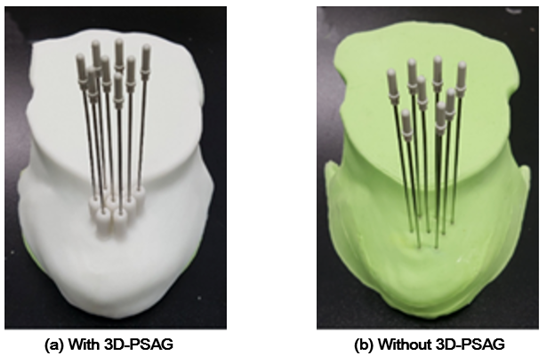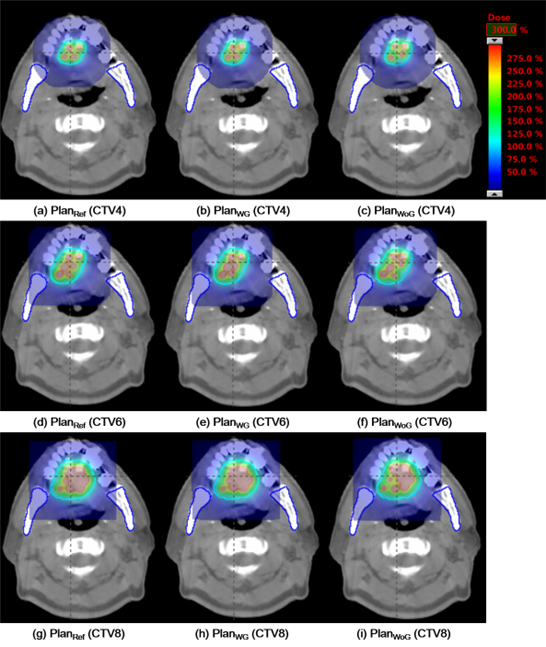글로벌 연구동향
의학물리학
- [Phys Med Biol.] A 3D-printed patient-specific applicator guide for use in high-dose-rate interstitial brachytherapy for tongue cancer: a phantom study.3차원 프린팅 기술을 적용하여 환자 맞춤형 조직내 근접방사선치료 장치를 개발하다.
서울의대 / 최창헌, 박종민*
- 출처
- Phys Med Biol.
- 등재일
- 2019 Jul 2
- 저널이슈번호
- 64(13):135002. doi: 10.1088/1361-6560/ab277e.
- 내용

그림1 . Tongue cancer HDR interstitial brachytherapy를 모사한 팬톰 실험에서, 니들을 삽입할 때에 3D 프린팅 환자맞춤형 가이드시스템을 적용한 경우(a)와 적용하지 않은 경우(b)

그림2 . 대표적인 환자 케이스의 axial 선량분포. 종양의 크기가 작을 때(위), 중간 크기일 때(중간), 종양이 클 때(아래)에 대하여, 치료계획 상의 선량분포(좌), 3D 프린팅 환자맞춤형 가이드 시스템 적용 시 선량분포(중간), 가이드 시스템 미적용 시 선량분포(우)를 보여주고 있음. 3D 프린팅 가이드 시스템을 적용했을 때에 치료계획 선량분포와의 차이가 적음을 확인할 수 있음.
Abstract
A patient-specific applicator guide system (PSAG) for tongue-cancer high-dose-rate (HDR) interstitial brachytherapy (ISBT) was developed by utilizing a 3D printing technique. An effectiveness of the 3D-printed PSAG (3D-PSAG) was evaluated for HDR ISBT. Six patients with tongue cancer were retrospectively selected for this study. For each patient, a total of three virtual clinical target volumes (CTV) requiring the insertion of four catheters (CTV4), six catheters (CTV6), and eight catheters (CTV8) were defined. For each CTV, treatment plans were generated to deliver 45 Gy in nine fractions. The 3D-PSAG was fabricated using a 3D-printer and the patient's CT-images. The resulting 3D-PSAG took the form of a shell conforming to the patient's contours with tubes for catheter insertion. For each CTV, catheters were inserted into the phantom with and without the 3D-PSAG. After that, CT-images of the phantom with the inserted catheters were acquired. Differences between the planned positions and those of the actually inserted catheters were evaluated from the CT-images. Given the actual catheter insertion positions, the dose distributions were reconstructed and analyzed. The maximum positional errors with and without the 3D-PSAG were 0.2 mm and 4.5 mm, respectively. For CTV6, the D 90% values of the original plan, the reconstructed plan with the 3D-PSAG, and the reconstructed plan without the 3D-PSAG, were 48.8 ± 1.7 Gy, 49.0 ± 2.9 Gy, and 45.6 ± 3.3 Gy, respectively. The D 1cc values for the mandible were 51.3 ± 9.2 Gy, 61.6 ± 8.3 Gy, and 81.1 ± 16.7 Gy, respectively. The dose homogeneities in the CTVs into which the catheters had been inserted with the 3D-PSAG were always superior to those into which the catheters had been inserted without the 3D-PSAG. The present phantom study demonstrated the feasibility of more accurate interstitial tongue brachytherapy while simplifying the treatment process by utilizing the 3D-PSAG.
Author informationChoi CH1, Kim JI, Park JM.
1
Department of Radiation Oncology, Seoul National University Hospital, Seoul, Republic of Korea. Institute of Radiation Medicine, Seoul National University Medical Research Center, Seoul, Republic of Korea. Biomedical Research Institute, Seoul National University College of Medicine, Seoul, Republic of Korea.
- 연구소개
- 본 연구에서는 HDR interstitial brachytherapy 시, 니들(needle)의 정확하고 용이한 삽입을 위하여, 환자맞춤형 가이드 시스템(3D-printed patient-specific applicator guide system, 3D-PSAG system)을 개발했습니다. 또한, 개발 시스템에 대하여 팬톰을 이용한 성능평가를 수행했습니다. HDR interstitial brachytherapy에서는 카테터를 치료계획과 동일하게 삽입하는 것이 정확한 치료를 위하여 매우 중요하나, 현재 이를 위한 가이드 시스템은 매우 제한적입니다. 따라서 본 연구에서는 3D 프린팅 기술을 이용하여 환자맞춤형 가이드 시스템을 개발하고, 3D 프린팅 기술로 제작한 팬톰을 이용하여 개발 시스템의 성능평가를 수행했습니다. 본 연구에서 수행한 실험 결과에 따르면, 개발 시스템은 삽입한 카테터의 위치 오류를 현저히 줄일 수 있었고, 이는 치료계획 선량분포와 실제 환자에게 전달될 것으로 예상되는 선량분포 사이의 차이를 감소시켰습니다. 또한, 본 개발 시스템은 시술자의 능력 및 경험에 대한 의존도를 줄여, HDR interstitial brachytherapy 치료의 상향평준화에 기여할 수 있을 것으로 생각합니다. 더불어, 본 시스템은 니들 삽입 시간을 줄일 수 있어, 시술자의 용이성 및 환자 편의성을 획기적으로 증대시킬 수 있습니다.
- 덧글달기









